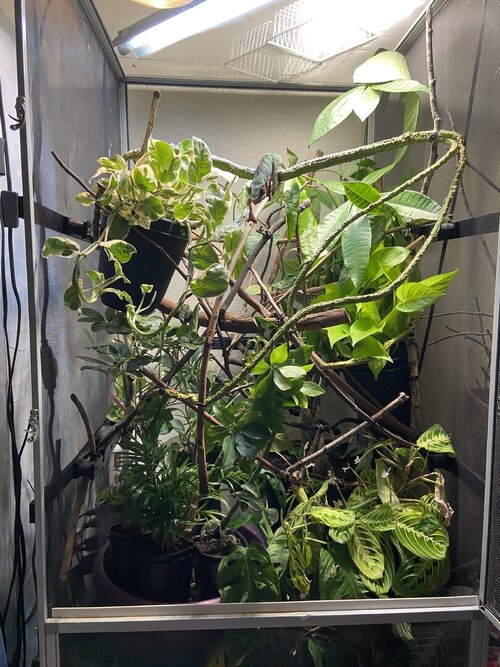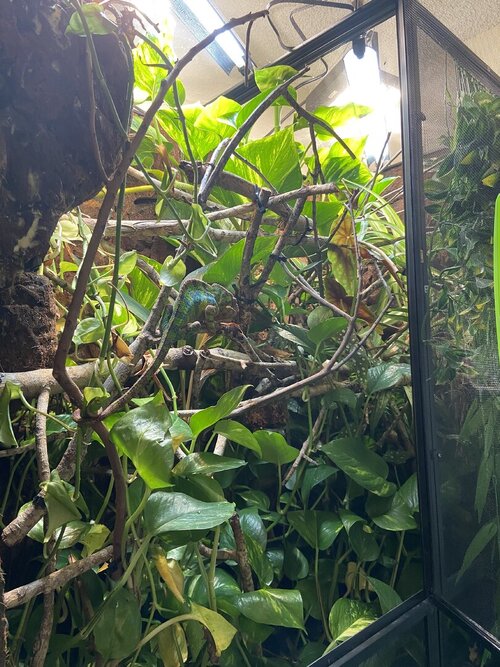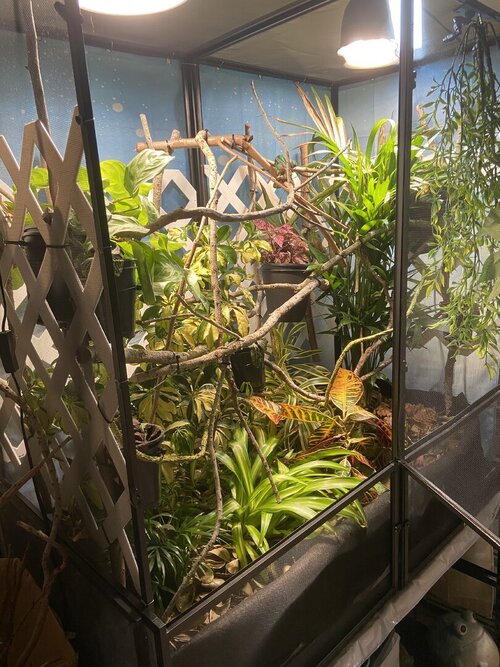Umbra
New Member
Hello chameleon forum members!
I have been reading post obsessively for about 4 days now attempting to learn as much as I can about keeping veiled chameleons. I recently came about 3 wild caught veileds unexpectedly and have been frantically gathering supplies and building a habitat for them. Two are a mating pair, and I believe the female has been knocked up very recently. The third was found in poor condition, and I’ll make a separate thread in the proper forum to discuss. I live in FL, and have a nice shady porch that doesn’t get direct sunlight, but stays very comfortable temp and humidity-wise for them, and they have started to settle in nicely (they drank and ate today unless my crickets have Houdini’ed their way out). I have been very careful to limit my interaction with them to reduce stress. I have many questions, and I am a sleep-deprived mess from obsessively researching and nervously helicopter parenting them, I don’t want to fail these guys! I’m sorry in advance for all my questions
Here’s what I need help with:
-what type of uvb bulb do I need for a shady patio that gets plenty of indirect sun, but no direct rays? How long should the light stay on?
- how close is too close for the mating pair? They were settling in together nicely at first, but have since separated to different plants. They’re able to wander, and have swapped plants twice. I have kept a close eye and have separated the female from the male once so far.
-how often should I be misting? I have been misting 3-4x a day for 3-4 mins to give them plenty of chances to drink (I have read on here that this is the best course for wild caught) and I have also set up a crude dripper for the short term.
-for my free rangers, how do you keep your feeders from running away? Sometimes my crickets jump off the plants and hide under the pots. Any good way to keep them contained to the plants?
-when should I present the female with a laying box/how will I know when she is ready to lay? The female has orange splotches over the body, but she doesn’t show much aggression to the male (no dark color change, but one instance where she hissed at him when he was in the way of her path).
-when and how should I begin to treat for parasites? The mating pair seems very healthy, but the lone male I’m concerned about.
-what are some good feeders that have a lot of vitamin A
Habitat info:
-extra thick ficus Benjamina
-extra thick umbrella plant
-towels under high traffic areas to cushion falls (the male likes climbing the screen at times)
-temps are in the high 80s to low 90s
-outside humidity avg is 65-70%, getting the tools to measure today.
Let me know if you need any info from me! Don’t roast me too badly, I’m trying my best ;-; Thank you for your time reading this
I have been reading post obsessively for about 4 days now attempting to learn as much as I can about keeping veiled chameleons. I recently came about 3 wild caught veileds unexpectedly and have been frantically gathering supplies and building a habitat for them. Two are a mating pair, and I believe the female has been knocked up very recently. The third was found in poor condition, and I’ll make a separate thread in the proper forum to discuss. I live in FL, and have a nice shady porch that doesn’t get direct sunlight, but stays very comfortable temp and humidity-wise for them, and they have started to settle in nicely (they drank and ate today unless my crickets have Houdini’ed their way out). I have been very careful to limit my interaction with them to reduce stress. I have many questions, and I am a sleep-deprived mess from obsessively researching and nervously helicopter parenting them, I don’t want to fail these guys! I’m sorry in advance for all my questions
Here’s what I need help with:
-what type of uvb bulb do I need for a shady patio that gets plenty of indirect sun, but no direct rays? How long should the light stay on?
- how close is too close for the mating pair? They were settling in together nicely at first, but have since separated to different plants. They’re able to wander, and have swapped plants twice. I have kept a close eye and have separated the female from the male once so far.
-how often should I be misting? I have been misting 3-4x a day for 3-4 mins to give them plenty of chances to drink (I have read on here that this is the best course for wild caught) and I have also set up a crude dripper for the short term.
-for my free rangers, how do you keep your feeders from running away? Sometimes my crickets jump off the plants and hide under the pots. Any good way to keep them contained to the plants?
-when should I present the female with a laying box/how will I know when she is ready to lay? The female has orange splotches over the body, but she doesn’t show much aggression to the male (no dark color change, but one instance where she hissed at him when he was in the way of her path).
-when and how should I begin to treat for parasites? The mating pair seems very healthy, but the lone male I’m concerned about.
-what are some good feeders that have a lot of vitamin A
Habitat info:
-extra thick ficus Benjamina
-extra thick umbrella plant
-towels under high traffic areas to cushion falls (the male likes climbing the screen at times)
-temps are in the high 80s to low 90s
-outside humidity avg is 65-70%, getting the tools to measure today.
Let me know if you need any info from me! Don’t roast me too badly, I’m trying my best ;-; Thank you for your time reading this








